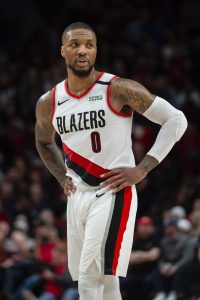The Trail Blazers, the West’s eighth seed, will now face off against the ninth-seeded Grizzlies in the first of two potential play-in tournament games on Saturday at 1:30 p.m. CT on ABC.
After an injury-plagued year, the Trail Blazers rode an impressive showing during their eight Orlando seeding games to a play-in tournament appearance as the West’s No. 8 seed. Portland defeated the Nets in a 134-133 nail-biter on Thursday, bringing the club’s Disney World record to 6-2.
The Blazers’ lone All-Star, Damian Lillard, poured in 42 points on Thursday and averaged a blistering 37.6 PPG during the eight seeding games, as the team wrapped up its cumulative regular season with a 35-39 finish
Despite a lackluster 2-6 showing in the seeding games, the Grizzlies had enough of a head start going into the restart to secure a play-in tournament berth, finishing the season with a 34-39 record.
Probable Rookie of the Year Ja Morant and starting center Jonas Valanciunas each posted triple doubles in a 119-106 vanquishing of the Bucks today. A one-game suspension prevented Milwaukee All-Star Giannis Antetokounmpo from suiting up against Memphis.
Per new rules developed for the NBA’s Orlando restart, Portland will enter the play-in tournament as the No. 8 seed and will need to win just one game against Memphis to advance to a first-round playoff matchup against the top-seeded Lakers next week.
If the No. 9 Grizzlies win on Saturday, there would be a second play-in game on Sunday between the two clubs. The winner of that second contest would face off against LeBron James, Anthony Davis, and company in a best-of-seven first round series.
Lillard has been the standout for the Trail Blazers, but center Jusuf Nurkic and power forward Zach Collins have proven to be crucial contributors upon returning from season-long injuries. Additionally, despite their limitations on defense, shooting guard CJ McCollum and small forward Carmelo Anthony will be tough covers for the Grizzlies’ young wings.
Morant will need to bear the brunt of Memphis’ offensive burden after Jaren Jackson Jr. suffered a season-ending meniscus tear last week. The Grizzlies will also be without Justise Winslow (hip) for the rest of the season and didn’t have backup point guard Tyus Jones (knee) available during the seeding games.
Despite being the only team to win all eight of its Disney World seeding games, the Suns narrowly missed out on an opportunity to make the play-in tournament. Phoenix finished its season with a 34-39 record thanks to a 128-102 drubbing of the Mavericks on Thursday. All-Star Suns guard Devin Booker and promising second-year center Deandre Ayton both impressed, complemented by a stellar young roster.
The Grizzlies, having won three of four games against the Suns during the regular season, had the tiebreaker edge over Phoenix, earning the right to compete in this weekend’s play-in.
The Spurs, meanwhile, missed the postseason for the first time since 1997, ending a 22-year playoff run that was easily the NBA’s longest active streak. San Antonio entered the restart planning to focus more on player development than on making the postseason, but played well, posting a 5-3 summer record. Head coach Gregg Popovich said after Thursday’s finale that he was very pleased with his club’s performance during the restart, per Eric Woodyard of ESPN.
“I’m more excited about this than anything you guys are talking about right now, successes or non-successes, because the success for streaks or whatever the hell you’re talking about ended,” Popovich said. “I could care less about that. I’m thrilled at the way they played here.”
Once either the Trail Blazers or Grizzlies win the play-in tournament, all eight first-round playoff matchups will be finalized. Details on the other seven series can be found right here.
The Suns, Spurs, and the loser of the play-in tournament will be part of the NBA’s draft lottery next Thursday, sorted by their records as of March 11. That means Phoenix will be 10th in the lottery standings, San Antonio will be 11th, and the Portland/Memphis loser will be 14th.
Luke Adams contributed to this post. Photo courtesy of USA Today Sports Images.
